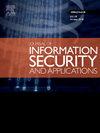VSEPDA: Verifiable secure and efficient privacy-preserving data aggregation protocol for image classification in federated learning
IF 3.8
2区 计算机科学
Q2 COMPUTER SCIENCE, INFORMATION SYSTEMS
Journal of Information Security and Applications
Pub Date : 2025-03-31
DOI:10.1016/j.jisa.2025.104039
引用次数: 0
Abstract
With the rapid advancement of big data and artificial intelligence, the vast amounts of data have facilitated the use of deep learning to create value, particularly in the domain of image classification. Unlike traditional deep learning methods that process data centrally, federated learning enables multiple users to collaboratively build models without data leaving local devices, effectively safeguarding user privacy. However, attackers can exploit gradient analysis to extract partial information from participants, and servers may return erroneous global models. As a result, developing a secure and verifiable federated learning scheme has become a focal point of current research. Recently, Tamer et al. introduced a communication-efficient and verifiable secure data aggregation protocol ESL+23, relying on lightweight cryptographic primitives with high computational efficiency. Nonetheless, we have identified significant shortcomings in the protocol’s verification capabilities: it is vulnerable to collusion attacks and intolerant of user dropouts. Therefore, this paper first designs an attack experiment, demonstrating a 100% success rate. Subsequently, we propose the VSEPDA protocol. Our security analysis indicates that VSEPDA offers enhanced fault tolerance and security. Finally, experiments show that VSEPDA achieves a 46.15% increase in computational efficiency for key updates. Using the real dataset, we demonstrate that the discrepancies in weights and biases between secure and traditional models are on the order of and , respectively, while maintaining equivalent image classification accuracy.
VSEPDA:用于联邦学习图像分类的可验证安全高效隐私保护数据聚合协议
随着大数据和人工智能的快速发展,海量的数据为深度学习创造价值提供了便利,尤其是在图像分类领域。与传统的集中处理数据的深度学习方法不同,联邦学习使多个用户能够在数据不离开本地设备的情况下协作构建模型,有效地保护了用户隐私。然而,攻击者可以利用梯度分析从参与者那里提取部分信息,并且服务器可能返回错误的全局模型。因此,开发一种安全、可验证的联邦学习方案已成为当前研究的热点。最近,Tamer等人引入了一种通信高效且可验证的安全数据聚合协议ESL+23,该协议依赖于具有高计算效率的轻量级加密原语。尽管如此,我们已经发现了协议验证能力的重大缺陷:它容易受到串通攻击,不能容忍用户退出。因此,本文首先设计了一个攻击实验,证明了100%的成功率。随后,我们提出了VSEPDA协议。我们的安全性分析表明,VSEPDA提供了增强的容错性和安全性。最后,实验表明,VSEPDA算法的密钥更新计算效率提高了46.15%。使用真实数据集,我们证明了安全模型和传统模型之间的权重和偏差分别在10−6和10−8的数量级上,同时保持等效的图像分类精度。
本文章由计算机程序翻译,如有差异,请以英文原文为准。
求助全文
约1分钟内获得全文
求助全文
来源期刊

Journal of Information Security and Applications
Computer Science-Computer Networks and Communications
CiteScore
10.90
自引率
5.40%
发文量
206
审稿时长
56 days
期刊介绍:
Journal of Information Security and Applications (JISA) focuses on the original research and practice-driven applications with relevance to information security and applications. JISA provides a common linkage between a vibrant scientific and research community and industry professionals by offering a clear view on modern problems and challenges in information security, as well as identifying promising scientific and "best-practice" solutions. JISA issues offer a balance between original research work and innovative industrial approaches by internationally renowned information security experts and researchers.
 求助内容:
求助内容: 应助结果提醒方式:
应助结果提醒方式:


